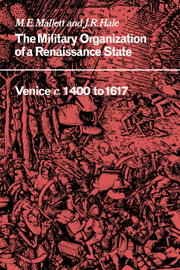Book contents
- Frontmatter
- Contents
- List of illustrations
- Acknowledgements
- References and abbreviations
- Map 1 The Terraferma in the fifteenth and sixteenth centuries
- Map 2 The empire da Mar
- PART I c. 1400 to 1508
- PART II 1509–1617
- 8 The historical role of the land forces 1509–1617
- 9 The wars
- 10 Government: policy, control and administration
- 11 The higher command
- 12 Manpower
- 13 Cavalry, infantry, artillery
- 14 Fortifications in the Terraferma
- 15 The defence of the maritime empire
- 16 The costs of defence and war
- Conclusion: the European context 1525–1617
- Appendix Infantry wages in the sixteenth century
- Select bibliography
- Index
15 - The defence of the maritime empire
Published online by Cambridge University Press: 22 October 2009
- Frontmatter
- Contents
- List of illustrations
- Acknowledgements
- References and abbreviations
- Map 1 The Terraferma in the fifteenth and sixteenth centuries
- Map 2 The empire da Mar
- PART I c. 1400 to 1508
- PART II 1509–1617
- 8 The historical role of the land forces 1509–1617
- 9 The wars
- 10 Government: policy, control and administration
- 11 The higher command
- 12 Manpower
- 13 Cavalry, infantry, artillery
- 14 Fortifications in the Terraferma
- 15 The defence of the maritime empire
- 16 The costs of defence and war
- Conclusion: the European context 1525–1617
- Appendix Infantry wages in the sixteenth century
- Select bibliography
- Index
Summary
The Venetian empire da Mar comprised a series of clusters of islands and ports ending in two widely spaced and weighty pendants, Crete and Cyprus. Acquired partly by conquest, partly by inheritance, purchase and gift, it reflected, in its long-drawn-out inconsequentiality, a dialogue between ship and shore that had been going on for centuries as Venetian merchant and war fleets sailed out and back between the lagoon and the Levant. The logical result of this exchange – on the one hand Venice's need for many ports of call (given the galley's scant space for provisions), a few strategic bases, and recruiting areas whence to ‘intraterzare’, or top up, crews; on the other the coastal population's desire for, or willingness to put up with, protection – could have been a continuous rim of Venetian service stations all the way to Famagosta, the break-off point for voyages to Beirut and Alexandria. As it was, by 1509 there were large gaps: at the Imperial Gulf of Trieste; along the coast of the Gulf of Quarnero between Istria and Venetian Dalmatia (which began at Novegradi), caused by the insurgency of the population crammed into western Croatia by incessant warfare in the Bosnian–Slovenian–Hungarian interior; between Curzola (Korcula) and Cattaro (Kotor), where the redoubtable energy of independent Ragusa represented a challenge rather than a threat; between Dulcigno (Ulcinj) and Butintro a longer stretch of insecure anchorages; between Crete and Cyprus, Venice's latest acquisition (1489), where the major stepping stone, Rhodes, was in the Christian, if not co-operative, hands of the Knights of St John (but only up to its conquest by the Turks in 1522).
- Type
- Chapter
- Information
- The Military Organisation of a Renaissance StateVenice c.1400 to 1617, pp. 429 - 460Publisher: Cambridge University PressPrint publication year: 1984



